Technical Tours
Technical Tour 1
Faulting in San Francisco Bay Area Tour with Andy Rathbun
Date: Saturday, 27 June 2105; 9:30 am - 6:30 pm
Cost: $140.00 Lunch and wine included
(Minimum 15 persons/Maximum 50)
We will explore the transition from creep to seismic faulting and view surface manifestations of fault creep and the interior of an ancient fault zone. This all-day tour will include fault-offset features in sidewalks and buildings in the town of Hollister, Calif., a visit to the DeRose Winery for a tasting and look at how the creeping fault is damaging their buildings, and a look at the Corona Heights Fault, an approx. 100 ft. tall by 300 ft. long slicken surface in Franciscian chert. Time permitting, other possible sites include sag ponds, scarps, gouge zones, and Mission San Jan Bautista.
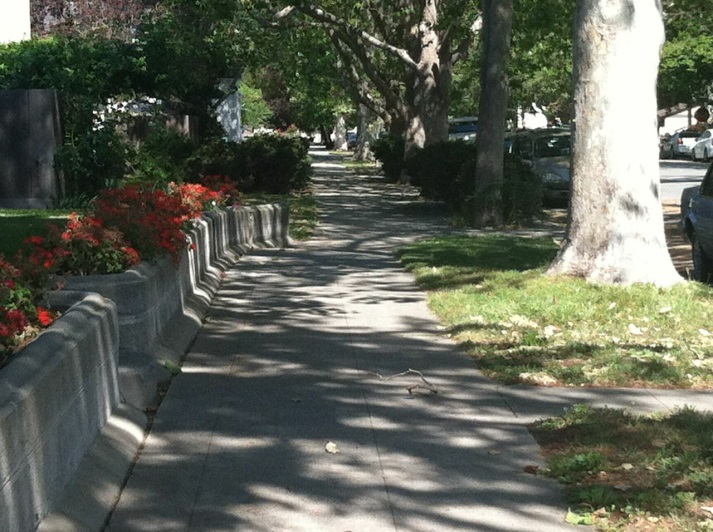 |
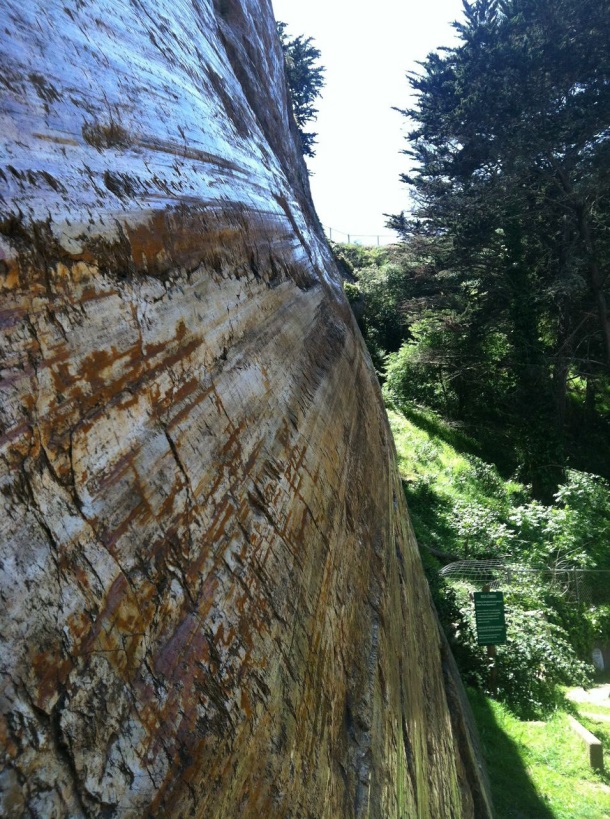 |
(Top) Corona Heights Fault, slickensurface, San Francisco, CA. Photo courtesy of Prof. Jamie Kirkpatrick, Colorado St. University. (Right) Along Strike view of the Corona Heights Fault and slickensurface, photo by A. Rathbun (Left) Offset sidewalk due to creep of the Calaveras Fault, Hollister, CA, photo by A. Rathbun |
|
Technical Tour 2
San Francisco Bay Geologic Engineering Tour with Richard Goodman
Date: Sunday, 28 June 2015; 8:00 am - 5:00 pm
Cost: $100.00 Lunch included (Minimum 30 persons/Maximum 50)
This technical tour will include selections from the following locations: Rock stability problems from historic quarry cuts into Telegraph Hill; Fort Point and the Golden Gate Bridge serpentinites; Franciscan Melange at Cliff House and Sutro Baths; Rock slope repair in chert and shale near Twin Peaks (optional stop at Twin Peaks if time and weather permit); Coastal defenses at Pacifica; The Devil’s Slide and decomposed granite and faulted coastal terraces of Montara Beach.
Richard Goodman, Professor Emeritus, University California, Berkeley; Ed Medley, Terraphase Engineering; and Dale Marcum and John Wallace, Cotton, Shires and Associates will lead the tour.
Technical Tour 3
The Geysers/Napa Valley Technical Tour with Russ Ewy
Date: Thursday, 2 July 2015; 7:00 a.m. – 6:30 p.m.
Cost: $180.00 Lunch and Wine Included
(Minimum 20 persons/Maximum 33)
The Geysers
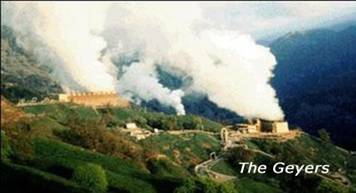 The Geysers is a complex of 22 geothermal power plants, drawing steam from more than 350 wells, located in the Mayacamas Mountains 72 miles north of San Francisco. The largest in the world, the Geysers has 1517 MW of active installed capacity with an average production factor of 63% (955 MW). Calpine Corporation operates and owns 19 of the 22 active plants in the Geysers and is currently the largest producer of geothermal energy in the United States. (From Wikipedia)
The Geysers is a complex of 22 geothermal power plants, drawing steam from more than 350 wells, located in the Mayacamas Mountains 72 miles north of San Francisco. The largest in the world, the Geysers has 1517 MW of active installed capacity with an average production factor of 63% (955 MW). Calpine Corporation operates and owns 19 of the 22 active plants in the Geysers and is currently the largest producer of geothermal energy in the United States. (From Wikipedia)
This tour will feature a special technical visit to the Geysers, site of a recent Enhanced Geothermal demonstration project. The tour will also include a stop at the Visitors Center, the Sonoma Overlook, the Fumaroles and boiling springs, the Little Geysers and the dead tree thermal zone. Lunch will be provided at the Geysers.
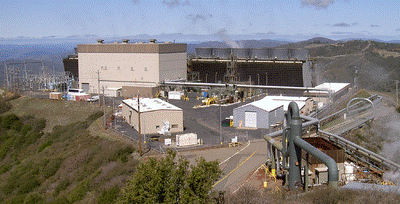 |
|
| The Sonoma Calpine 3 power plant is one of 22 power plants at The Geysers. From Wikipedia. |
Palmaz Vineyards
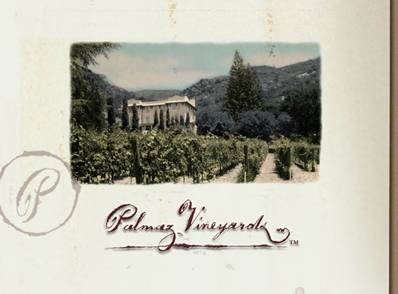 The second part of this technical tour will feature a visit to the Palmaz Vineyards, a well-known and respected a Napa Valley winery. The Palmazes bought a forgotten stone winery, a fine old house badly in need of renovation, and acres of land that had once produced fine Napa wines. The little valley had been the site of Cedar Knoll Vineyard and Winery, founded in 1881 by Henry Hagen, one of Napa Valley's pioneer winemakers. Henry Hagen produced wines that garnered many awards, including a silver medal at the Paris Exposition of 1889. Prohibition in the 1920s was fatal to the vineyard--the winery fell into disrepair and the vineyards lay fallow for nearly eighty years. Today, the vineyards are burgeoning, the restored Hagen house is a family home again, and the winery has been reinvented.
The second part of this technical tour will feature a visit to the Palmaz Vineyards, a well-known and respected a Napa Valley winery. The Palmazes bought a forgotten stone winery, a fine old house badly in need of renovation, and acres of land that had once produced fine Napa wines. The little valley had been the site of Cedar Knoll Vineyard and Winery, founded in 1881 by Henry Hagen, one of Napa Valley's pioneer winemakers. Henry Hagen produced wines that garnered many awards, including a silver medal at the Paris Exposition of 1889. Prohibition in the 1920s was fatal to the vineyard--the winery fell into disrepair and the vineyards lay fallow for nearly eighty years. Today, the vineyards are burgeoning, the restored Hagen house is a family home again, and the winery has been reinvented.
Tour of the Wine Cave
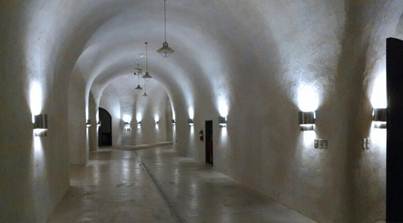 Palmaz Vineyards' winemaking and aging take place within the living rock of Mount George in a flawlessly engineered maze of tunnels and lofty domes. The height of the wine cave is equivalent to an 18-story building, providing the vertical range needed for true gravity-flow winemaking. Thus, the wine is never subjected to the violent agitation of pumping, which can change the wine’s intra-molecular structure. This gentle treatment allows the finest nuances of flavor to develop naturally—the result is a complex, elegant wine.
Palmaz Vineyards' winemaking and aging take place within the living rock of Mount George in a flawlessly engineered maze of tunnels and lofty domes. The height of the wine cave is equivalent to an 18-story building, providing the vertical range needed for true gravity-flow winemaking. Thus, the wine is never subjected to the violent agitation of pumping, which can change the wine’s intra-molecular structure. This gentle treatment allows the finest nuances of flavor to develop naturally—the result is a complex, elegant wine.
Some facts about the wine cave:
- The fermentation dome is the world’s largest underground reinforced structure. It is 72’ in diameter and 54’ high.
- Temperature stays constant at 60 degrees and humidity at 75%, the perfect atmosphere for aging wine.
- The cave houses its own water treatment plant built to comply with strict conservation guidelines.
- Fermentation tanks rotate on a custom-designed carousel.
The Tasting
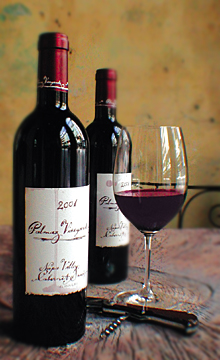 Guests will be served the following wines paired with a small hors d' oeuvre:
Guests will be served the following wines paired with a small hors d' oeuvre:
- Palmaz Vineyards Riesling "Louise"
- Palmaz Vineyards Chardonnay "Amalia"
- Palmaz Vineyards Cabernet Sauvignon Current Vintage
- Palmaz Vineyards Cabernet Sauvignon Select Library Release
- Palmaz Vineyards Muscat Canelli "Florencia"
The selection of wines may vary depending on availability.
